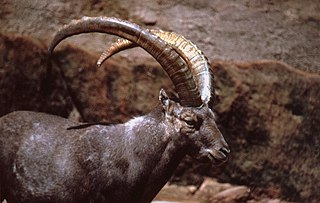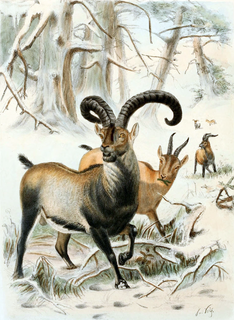
The subfamily Caprinae is part of the ruminant family Bovidae, and consists of mostly medium-sized bovids. A member of this subfamily is called a caprine, or, more informally, a goat-antelope; however, this term "goat-antelope" does not mean that these animals are true antelopes: a true antelope is a bovid with a cervid-like or antilocaprid-like morphology.

An ibex is any of several species of wild mountain goat , distinguished by the male's large recurved horns, which are transversely ridged in front. Ibex are found in Eurasia, North Africa, and East Africa. The name ibex comes from Latin, borrowed from Iberian or Aquitanian, akin to Old Spanish bezerro "bull", modern Spanish becerro "yearling". Ranging in height from 27 to 43 inches and weighing 200 to 270 pounds, ibex can live 20 years. Two closely related varieties of goats found in the wild are not usually called ibex: the markhor and the feral goat.

The University of Kentucky is a public land-grant research university in Lexington, Kentucky. Founded in 1865 by John Bryan Bowman as the Agricultural and Mechanical College of Kentucky, the university is one of the state's two land-grant universities and the institution with the highest enrollment in the state, with 30,545 students as of fall 2019.

The Alpine ibex, also known as the steinbock, bouquetin, or simply ibex, is a species of wild goat that lives in the mountains of the European Alps. It is a sexually dimorphic species with larger males that carry larger, curved horns. Their coat colour is typically brownish grey. Alpine ibex tend to live in steep, rough terrain near the snow line. They are also social, although adult males and females segregate for most of the year, coming together only to mate. Four distinct groups exist; adult male groups, female-offspring groups, groups of young individuals, and mixed-sex groups.

Capra is a genus of mammals, the goats, composed of up to nine species, including the wild goat, the markhor, and several species known as ibexes. The domestic goat is a domesticated subspecies of the wild goat. Evidence of goat domestication dates back more than 8,500 years.
The IBEX 35 is the benchmark stock market index of the Bolsa de Madrid, Spain's principal stock exchange. Initiated in 1992, the index is administered and calculated by Sociedad de Bolsas, a subsidiary of Bolsas y Mercados Españoles (BME), the company which runs Spain's securities markets. It is a market capitalization weighted index comprising the 35 most liquid Spanish stocks traded in the Madrid Stock Exchange General Index and is reviewed twice annually. Trading on options and futures contracts on the IBEX 35 is provided by MEFF, another subsidiary of BME.

Ibex Airlines Co., Ltd. is a Japanese regional airline headquartered in Kōtō, Tokyo, Japan. It operates Japanese domestic services with its main base at Sendai Airport, Natori, Miyagi.

The Iberian ibex, Spanish ibex, Spanish wild goat, or Iberian wild goat is a species of ibex with four subspecies. Of these, two can still be found on the Iberian Peninsula, but the remaining two are now extinct. The Portuguese subspecies became extinct in 1892 and the Pyrenean subspecies became extinct in 2000. An ongoing project to clone to the Pyrenean subspecies resulted in one clone being born alive in July 2003. This is the first taxon to become "un-extinct", although the clone died a few minutes after birth due to physical defects in lungs.

The Nubian ibex is a desert-dwelling goat species found in mountainous areas of northern and northeast Africa, and the Middle East. Its range is within Algeria, Egypt, Ethiopia, Eritrea, Israel, Jordan, Oman, Saudi Arabia, Sudan, and Yemen. It is extirpated in Lebanon. It is historically considered to be a subspecies of the Alpine ibex, but is increasingly considered a specifically distinct species. The wild population is estimated at 1,200 individuals.
The Pliensbachian is an age of the geologic timescale and stage in the stratigraphic column. It is part of the Early or Lower Jurassic epoch or series and spans the time between 190.8 ± 1.5 Ma and 182.7 ± 1.5 Ma. The Pliensbachian is preceded by the Sinemurian and followed by the Toarcian.

Interstellar Boundary Explorer (IBEX) is a NASA satellite in Earth orbit that uses energetic neutral atoms (ENAs) to image the interaction region between the Solar System and interstellar space. The mission is part of NASA's Small Explorer program and was launched with a Pegasus-XL rocket on October 19, 2008.
Ibex are various mountain goat species.

Gran Paradiso National Park, is an Italian national park in the Graian Alps, between the Aosta Valley and Piedmont regions. The park is named after Gran Paradiso mountain, which is located in the park, and is contiguous with the French Vanoise national park. The land the park encompasses was initially protected in order to protect the Alpine ibex from poachers, as it was a personal hunting ground for king Victor Emmanuel II, but now also protects other species.

The walia ibex is an endangered species of ibex. It is sometimes considered a subspecies of the Alpine ibex. Threats against the species include habitat loss, poaching, and restricted range; only about 500 individuals survived in the mountains of Ethiopia, concentrated in the Semien Mountains, largely due to past poaching and habitat depletion. If the population were to increase, the surrounding mountain habitat would be sufficient to sustain only 2,000 ibex. The adult walia ibex's only known wild predator is the hyena. However, young ibex are often hunted by a variety of fox and cat species. The ibex are members of the goat family, and the walia ibex is the southernmost of today's ibexes. In the late 1990s, the walia ibex went from endangered to critically endangered due to the declining population. The walia ibex is also known as the Abyssinian ibex.
Ibex Mountain is a young cinder cone in the Yukon Territory, Canada, located 33 km southwest of Whitehorse and 12 km southeast of Mount Arkell. It is in a group of basaltic cones and lava flows called Alligator Lake and is in the Northern Cordilleran Volcanic Province. It is believed Ibex Mountain last erupted during the Pleistocene. Ibex Mountain is at the head of the Ibex River, which is southeast of Whitehorse. There is a road that runs close to Ibex Lake on the southeast side of the summit. From there is the hike to the summit of the cone.

The Siberian ibex, also known as the Altai ibex or Gobi ibex, is a species of ibex that lives in central Asia. It has traditionally been treated as a subspecies of the Alpine ibex, and whether it is specifically distinct from other ibex is still not entirely clear. It is the longest and heaviest member of the genus Capra, though its shoulder height is surpassed by the markhor.
Meta Financial Group, Inc., is the holding company for MetaBank, N.A., Member Federal Deposit Insurance Corporation. Headquartered in Sioux Falls, S.D., MetaBank operates in several segments within the Banking and Payments industries: MetaBank, its traditional retail banking operation; Meta Payment Systems, its electronic payments division; AFS/IBEX, its insurance premium financing division; and Refund Advantage, EPS Financial and Specialty Consumer Services, its tax-related financial solutions divisions.

Ibex Cave is a limestone cave on the Rock of Gibraltar which has yielded stone artifacts of Mousterian tradition. It was discovered in 1975. It is so named as an ibex skull was found within the cave which would have been hunted by the Neanderthals of Gibraltar thousands of years ago. Ibex Cave was named and excavated by the Gibraltar Museum in 1994. Its first formal description was in 1999.

The Pyrenean ibex, Aragonese and Spanish common name bucardo, Catalan common name herc and French common name bouquetin was one of the four subspecies of the Iberian ibex or Iberian wild goat, a species endemic to the Pyrenees. Pyrenean ibex were most common in the Cantabrian Mountains, Southern France, and the northern Pyrenees. This species was common during the Holocene and Upper Pleistocene, during which their morphology, primarily some skulls, of the Pyrenean ibex was found to be larger than other Capra subspecies in southwestern Europe from the same time.

Ibex Peak (Arizona), at 2,824 feet (861 m), is a highpoint in the northern section of the Plomosa Mountains of western Arizona, near the Colorado River. The mountain range is a north-south range on the east side of the north-south La Posa Plain which parallels the Colorado River and the river valley of Parker Valley.
















